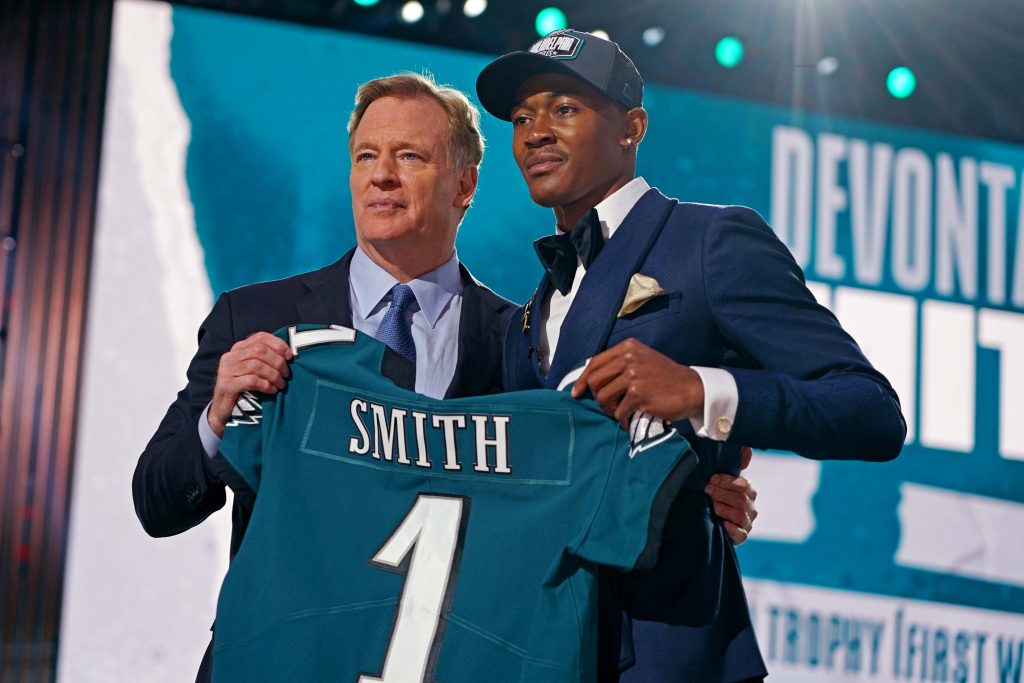NFL draft notebook: NFC East drama shakes up first round
After a mostly predictable start, three NFC East rivals cranked up the intrigue in the 2021 NFL Draft with high-stakes maneuvers that reshaped the proceedings.
The Dallas Cowboys, due up at No. 10, openly coveted one of the top two cornerbacks in the class, Alabama’s Patrick Surtain II or South Carolina’s Jaycee Horn. But the Carolina Panthers made Horn the first defensive player off the board at No. 8 and the Denver Broncos chose Surtain at No. 9, leaving Dallas empty-handed.
Listen as the #DallasCowboys call @MicahhParsons11 to tell him that he is officially a 🤠
🔈 Secret Audio presented by @ATT pic.twitter.com/urj5ErZR8S
— Dallas Cowboys (@dallascowboys) April 30, 2021
Meanwhile, Heisman Trophy-winning wide receiver DeVonta Smith of Alabama was still available at No. 10, with the New York Giants possibly interested in him at No. 11. The Philadelphia Eagles made a rare deal, executing a trade with one division rival to leapfrog another.
The receiver-needy Eagles jumped to the 10th pick to select Smith by trading the 12th and 84th overall picks to the Cowboys. Dallas used the No. 12 pick on Penn State linebacker Micah Parsons rather than a corner.
Jalen Hurts and DeVonta Smith reunited
— John Clark (@JClarkNBCS) April 30, 2021
“When you trade it in the division, you understand that you’re not going to get any values (added) to that, either. It’s going to have to work for them as well,” Eagles general manager Howie Roseman said.
Good morning. ☕️
DeVonta Smith is a Philadelphia Eagle.#FlyEaglesFly pic.twitter.com/d3KP6YIaiA
— Eagles Nation (@PHLEaglesNation) April 30, 2021
The turn of events had consequences.
With Smith gone, the Giants instead traded back with the Chicago Bears, who moved up from No. 20 to No. 11 to land Ohio State’s Justin Fields, the fourth quarterback chosen.
At No. 20 the Giants went with a different wide receiver, slot Kadarius Toney of Florida. It marked the first time Dave Gettleman traded back in eight drafts as general manager of the Giants and the Carolina Panthers.
Hoping for a pass rusher, team drafts a WR. #NYGiants #NFLDraft2021 pic.twitter.com/jBi0QbPne1
— Christopher Neto CTS (@chris_neto) April 30, 2021
The Giants select Gators WR Kadarius Toney with the No. 20 pick in the #NFLDraft 😤 pic.twitter.com/VXQND9TAlL
— B/R Gridiron (@brgridiron) April 30, 2021
Belichick stands Pat for QB: The New England Patriots didn’t have to trade up to snag one of the best quarterbacks available. Alabama’s Mac Jones fell to the Patriots at No. 15.
“All of New England is really happy with this pick.”
Inside the #PatsDraft room the moment @MacJones_10 became a Patriot. pic.twitter.com/szRjnmnPe7
— New England Patriots (@Patriots) April 30, 2021
Now he’s tasked with becoming New England’s next franchise quarterback more than a year after Tom Brady left for the Buccaneers.
“I can’t wait to play for the greatest franchise in NFL history,” Jones said.
Records for offense, Alabama: The first seven picks of the draft were offensive players for the first time. The previous mark was six straight offensive players to open the 1999 draft.
After quarterbacks went 1-2-3, the Atlanta Falcons selected highly touted tight end Kyle Pitts. The Cincinnati Bengals chose LSU receiver Ja’Marr Chase fifth, the Miami Dolphins selected Alabama receiver Jaylen Waddle sixth and the Detroit Lions chose Oregon offensive tackle Penei Sewell seventh.
Nick Saban’s pro factory in Tuscaloosa also had an historic night, as the Crimson Tide tied a record with six players chosen in the first round of a single draft. The 2004 Miami Hurricanes had the first draft class with six first-rounders.
After Waddle, Surtain, Smith and Jones, the Las Vegas Raiders reached at No. 17 for Alabama tackle Alex Leatherwood, who projects as a right tackle on their depth chart with Kolton Miller locked in at left tackle. The Pittsburgh Steelers then drafted running back Najee Harris at No. 24 to bolster a thin depth chart at the position.
Fun fact about the Raiders’ No. 17 pick Alex Leatherwood:
He’s a “meme connoisseur” with over 1,000 memes saved on his phone 😆 #NFLDraft pic.twitter.com/OtpR8zqfTM
— NFL on ESPN (@ESPNNFL) April 30, 2021
Jags, Jets take two: The entire NFL knew the Jacksonville Jaguars and New York Jets would select quarterbacks Trevor Lawrence and Zach Wilson with the first two picks. But both teams had a second first-round pick to spend toward building their teams around their respective rookies.
The Jets owned the Seahawks’ 23rd pick from last year’s Jamal Adams trade. They packaged that and two third-rounders to the Minnesota Vikings to move up to No. 14 and take the top-rated offensive guard in the class, Alijah Vera-Tucker of Southern Cal. Vera-Tucker figures to slot in next to last year’s first-round pick, mammoth tackle Mekhi Becton, to protect Wilson.
The Jaguars used the 25th overall pick (from the Los Angeles Rams in the Jalen Ramsey trade) to reunite Lawrence with his Clemson teammate, running back Travis Etienne. Etienne is the ACC’s all-time leading rusher with high marks of 4,952 yards and 70 touchdowns over four seasons.


